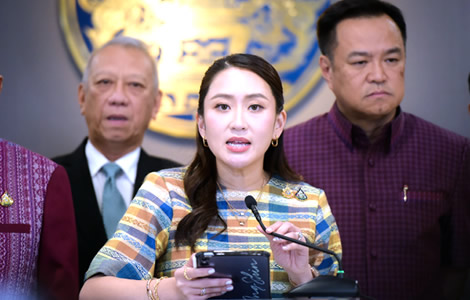Thailand introduces a major debt restructuring plan for nearly 2 million borrowers, aiming to ease the borrowing crisis with new concessions and a focus on repayment reduction. The government’s intervention targets bad debts and offers hope for economic stability.
The Thai government this week introduced a significant debt restructuring provision aimed at nearly 2 million borrowers with debts of ฿1.3 trillion. This move comes as household debt levels are beginning to move downward. In effect, this is being caused by strict central bank lending criteria and the country’s major financial institutions reining in credit. Figures in November showed that Thai banks have reduced their loan books by 2% to the lowest level since 2010. However, in the meantime, the country is facing a brewing crisis, as bad debt and non-performing loans have surged compared to a year ago.

Nonetheless, there are signs of improvement except for the distressed SME sector. Loan advances in some areas have fallen in the third quarter. However, the reason is deteriorating loan quality.
The new debt restructuring initiative announced on Wednesday will see borrowers approved for the scheme save on interest repayments. In short, lower monthly repayments at 50% in the first year will go directly to reducing the principal amount owed.
On Wednesday, the government of Paetongtarn Shinawatra announced the debt restructuring programme for hard-pressed borrowers in Thailand. The programme is themed “You Fight, We Help.” In particular, it is aimed at loans not overdue by more than a year.
In short, this is an intervention by the government. It is coming at a time when the level of non-performing debt overall in Thailand is surging. Indeed, it could be said that Thailand’s overextended economy is experiencing a repayment crisis.
Stricter lending policies drive the first contraction in Thai household debt amid tightening credit criteria
Certainly, the country’s macro-financials are sound. Therefore, the central bank, or Bank of Thailand, is in a position to both influence and support a government solution. This explains the tension between the government and the bank since last year. However, there is evidence—certainly from this initiative—that the Bank of Thailand is listening.
Since the beginning of 2024, the bank has been tightening household credit, particularly on auto loans and personal finance. Hence, the sales of automobiles fell 25.4% in the first three quarters of 2024.
The hardline policy by the central bank is starting to show results. Household debt as of the end of June was ฿16.35 trillion or 89.6% of GDP. In short, it fell from 90.7% in the first quarter.
At the same time, banks in Thailand have been lending less. Thailand has just seen its first actual contraction in household debt among commercial banks, which accounts for 38.5% of overall private sector credit.
Larger, more financially capable borrowers are repaying bank loans. In the meantime, financial institutions are cutting their loan books. For instance, in November, Bank of Thailand Assistant Governor Suwannee Jesadasak revealed that banks under its supervision had pulled in their loan books by 2%. Indeed, the amount of loans outstanding was the lowest since 2010.
Surging bad debts signal growing risks in the banking sector as non-performing loans reach critical levels
Meanwhile, bad debts are rising. According to the latest official figures from the central bank, non-performing loans (NPLs) stood at 2.97%. At the same time, it is admitted that loan quality is deteriorating.
The National Credit Bureau (NCB) in November provided more illuminating information. A briefing was given by Mr. Surapol Opasathian on November 22. Mr. Surapol supervises an organization that pools data from 157 Thai financial institutions.
Its data covers 30 million people with ฿13.6 trillion under review. In short, overall debt was up 0.5% from 2023. Significantly, however, credit contracted by 0.2% from the previous quarter.
However, bad debt or non-performing loans rose dramatically. They were up by 14.1% at the end of the third quarter of 2024, compared to last year. The total amount was ฿1.2 trillion. Furthermore, this was up from the second quarter by 3.4%.
In short, Thailand is in the midst of a bank debt crisis, one which it is battling.
Manufacturing slowdown and rising unemployment weigh on struggling small businesses in Thailand
In particular, the bureau has noticed real signs of distress in the SME sector. Indeed, this coincides with a rise in officially recorded unemployment. It has aligned with the closure of manufacturing concerns, particularly in the auto sector.
Certainly, many firms have been hit by cheaper products and undercutting from China. At length, the Ministry of Commerce revealed last week that it was tackling a problem with nominees controlling Thai companies, with nearly three-quarters of these operators originating in China.
Meanwhile, it should be noted that Thai economic data will always be suspect. The main reason, of course, is the massive black economy. This week, Prime Minister Paetongtarn Shinawatra vowed to tackle this. She estimated it was 49% of Thailand’s real GDP. However, it may be even higher.
Therefore, this may help explain why, boosted by foreign tourism and domestic consumption supported by a government handout of ฿145 billion in September, the Thai economy grew by 2.9% in the third quarter. At length, the economy’s resilience is due to the parallel black market, which feeds into stronger domestic consumption.
Undoubtedly, the latter has funded growth in the third quarter of 2024, while manufacturing and hard-pressed borrowers struggled.
Youth unemployment and credit constraints point to systemic challenges in Thailand’s economic structure
In the meantime, 81,000 people were reported as unemployed at the end of September. This was up 16.2% from 2023. Even more striking was that 65% reported problems finding alternative employment. At the same time, 71.3% had never been unemployed before, and 75% of them were 20–29 years of age.
In short, Thailand’s registered economy is struggling, while the unregistered economy is helping to power domestic consumption. This is happening despite the borrowing crisis.
This brings us to the government’s scheme announced on Wednesday. Certainly, it avoids the issue of moral hazard. While provisions are made to help delinquent borrowers and those in severe straits, the focus is on those who have had a good repayment history.
The plan targets approximately ฿1.2 trillion to ฿1.3 trillion in outstanding debt and up to 2.3 million accounts.
Firstly, those availing of the scheme must register. It covers loans advanced before January 1, 2024. It includes home loans, business loans, personal loans, vehicle loans, and other specialized loans such as digital loans.
Debt relief program targets repayment incentives and assists delinquent borrowers with concessions
In particular, the caps are ฿5 million for home properties or business advances. For vehicles, it is ฿800,000, while for motorbikes, the figure is ฿50,000. Personal loans of up to ฿200,000 are also covered.
The borrowers cannot have overdue repayments beyond a year.
If approved, they can choose to reduce their monthly repayments over a three-year period to 50%, 70%, or 90%. These repayments would, in effect, go directly to paying off the principal. In brief, interest will be suspended, with the government compensating the financial institutions.
Furthermore, debts under ฿5,000 can be written off, subject to approval. This is designed to allow these borrowers to rehabilitate their credit scores.
In addition, the scheme provides for delinquent borrowers with a provision where 10% of bad loans are paid by the borrower, with the government and financial institutions covering the rest. Indeed, the government will pay 45% and the bank or lender another 45%. This is essentially for selective borrowers who meet key criteria.
Bold measures tackle chronic debt issues while ensuring a soft landing for Thailand’s fragile economy
Overall, this intervention aims to reward borrowers who make an effort to pay. At the same time, it offers borrowers under pressure an opportunity to redeem their credit history.
Nonetheless, this program by the government should not be seen as an effort to spur growth. Certainly, it is an effort to deal with a brewing private-sector debt crisis. In brief, it aims for a soft landing from this crisis.
In the meantime, banks continue to pull in their horns while there is evidence that out-of-control lending is presently being curbed.
On Wednesday, Ms. Paetongtarn Shinawatra pledged her government would also help deliver further assistance. This would come through village funds and other channels to help the less well-off.
Meanwhile, after Wednesday’s Cabinet meeting at Government House, Minister of Finance Pichai Chunhavajira explained that a reduction in the Financial Institutions Development Fund (FIDF) monthly payments for financial institutions would help facilitate borrower concessions.
Fund established after 1997 crisis provides ฿38.92 billion to support under-pressure banks and institutions
This fund was established in the aftermath of the 1997 Financial Crisis. Previously, it was used to support under-pressure banks and institutions. The concession to banks by the government amounts to ฿38.92 billion.
Undoubtedly, what was announced this week is a significant and bold step toward addressing Thailand’s chronic problems. Despite political pressure, the Bank of Thailand since the beginning of the year has held firm in reining in borrowing.
In the meantime, there is a long road ahead. The present government needs time and stability to help the economy weather this borrowing crisis. Afterwards, if exports and foreign tourism continue to hold up, it may help to underpin stronger GDP growth outcomes.
Financial experts and economists in sombre warning to government: Hands off the Bank of Thailand
Sirikanya criticises the government’s economic agenda as willy-nilly and focused on cash handouts
Presently, Thailand is expected to see GDP growth for 2024 at 2.7%. However, stronger exports and a return of high-spending Western tourists in large numbers toward the end of the year may see growth of up to 3% achieved.
Undoubtedly, if the government can show that household debt is falling and that a borrowing crisis is being averted, then this growth outcome would spell significant and welcome progress.
Join the Thai News forum, follow Thai Examiner on Facebook here
Receive all our stories as they come out on Telegram here
Follow Thai Examiner here
Further reading:
Trump’s trifecta triumph means Thailand will be more on edge as he prepares to take power in January
Ung Ing congratulates Trump as Thailand uneasily confronts the meaning of his second Presidency
Paetongtarn’s government set to tackle the evil of chronic debt in Thailand as the tide still rises
Srettha’s crisis is not just an economic one, it is a ‘3D debt crisis’ that is strangling GDP growth
Zombie Thai firms holding back economic growth as they struggle just to pay interest on bank debt
Incoherent government economic policy clashes with Bank of Thailand’s efforts to rein in debt


















